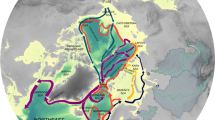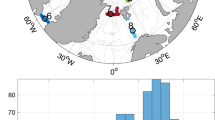Abstract
TELLURIC current recording equipment was operated on Arctic Drifting Station Charlie during the epoch October 15–December 31, 1959. The station was located on a 4-mile by 7-mile ice floe of quite uniform thickness, the thickness averaging perhaps 10 ft. The electrodes consisted of 8-ft. by 2-in. lead strips prepared from electric cable sheathing. Electrode pairs were cut from continuous lengths of sheathing to assure identity of material in the two electrodes. No difficulty was experienced with contact potentials. The d.c. voltage never exceeded a few millivolts and was very steady. The electrodes were suspended in the sea just below the ice at a spacing of 1.082 km. The relatively long spacing was necessary because of the low mV./km. value experienced over the highly conducting sea water.
This is a preview of subscription content, access via your institution
Access options
Subscribe to this journal
Receive 51 print issues and online access
$199.00 per year
only $3.90 per issue
Buy this article
- Purchase on Springer Link
- Instant access to full article PDF
Prices may be subject to local taxes which are calculated during checkout
Similar content being viewed by others
Author information
Authors and Affiliations
Rights and permissions
About this article
Cite this article
HESSLER, V. Telluric Current Micropulsations on Arctic Drifting Station Charlie. Nature 188, 567–568 (1960). https://doi.org/10.1038/188567b0
Issue Date:
DOI: https://doi.org/10.1038/188567b0
Comments
By submitting a comment you agree to abide by our Terms and Community Guidelines. If you find something abusive or that does not comply with our terms or guidelines please flag it as inappropriate.



